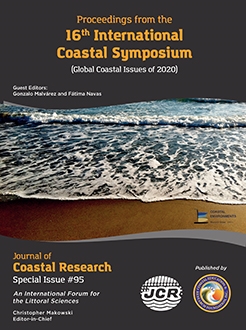d'Amico, D.; Larroque, B.; Luthon, F.; Poncet, P.A., and Abadie, S., 2020. Continuous measurement and automatic processing of in-situ wave impact pressure data. In: Malvárez, G. and Navas, F. (eds.), Global Coastal Issues of 2020. Journal of Coastal Research, Special Issue No. 95, pp. 214-219. Coconut Creek (Florida), ISSN 0749-0208.
Although wave impact has been extensively studied in laboratories, field studies are comparatively rare. However, as real wave impacts are influenced by numerous environmental factors, complementing physical studies with in-situ data is necessary to better understand the processes at stake and provide reliable tools for coastal engineers. One of the main reasons for the lack of field data is the extreme conditions usually met on site. Nowadays, technology allows to set up stations able to resist those conditions and record data over long periods. In this context, the so-called Artha breakwater, in the French Basque coast, was equipped with an in-situ laboratory to record wave impact pressures. This station enables to collect long term wave impact pressure data therefore covering any weather conditions. In the present paper, the use of computer engineering based methods to process the large amount of wave impact data is described. It involves signal pre-processing, impact automatic segmentation, automatic computation of impact parameters, and artificial intelligence to classify the impacts. Impact automatic segmentation allows to have a big database of impacts available. This database has been used to make a first classification of the strongest impacts. The classification was performed thanks to the parameters automatically computed for each impact. As preliminary results for the classification, several wave impact pressure classes have been established. The approach is encouraging since the obtained results can be compared with the existing laboratory classification. However, the results can still be improved by computing other impact parameters and considering all impacts.





